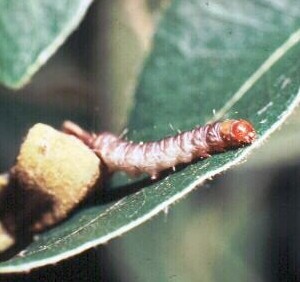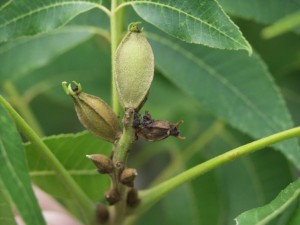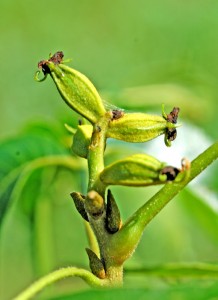 Pecan trees are one of the most beloved trees of all time. And like all other trees, the yield of the tree, as well as their quality are governed by a number of environmental factors. Environmental conditions, management inputs, and pest pressure all have direct impacts on pecan yield or nut quality. One pest that is a major threat to the pecan tree is the pecan nut casebearer. The pecan nut casebearer is one of the most devastating nut-feeding insects that occur in pecans. They may damage the nuts and reduce the yield of the tree considerably.
Pecan trees are one of the most beloved trees of all time. And like all other trees, the yield of the tree, as well as their quality are governed by a number of environmental factors. Environmental conditions, management inputs, and pest pressure all have direct impacts on pecan yield or nut quality. One pest that is a major threat to the pecan tree is the pecan nut casebearer. The pecan nut casebearer is one of the most devastating nut-feeding insects that occur in pecans. They may damage the nuts and reduce the yield of the tree considerably.
The pecan nut casebearer is found throughout pecan growing regions from Florida to southern New Mexico. In Oklahoma, adult casebearer moths deposit eggs during late May or early June. Eggs are deposited on the tips of nuts shortly after tree pollination. After hatching, the larvae burrow into nuts. Each larva may damage an entire cluster. Pecan trees typically lose 75 percent of the pecans between nut set and shell hardening even when protected from insect damage. As casebearer larvae feed on the inside of pecans, they push all their frass outside into a nice neat pile. The pecan nut casebearer has established itself in over 70 percent of the pecan-producing areas in the western region of New Mexico. Within the next four years, it is estimated that these bugs will establish in the majority of the remaining pecan acres.
 Larval feeding prior to hard shell typically results in significant damage to the nut, formation of an abscission layer, and loss of the nut. During the period of the pecan’s shell hardening a percentage of nuts are susceptible to yield loss caused by late second- and early third-generation larvae. Crop loss during the late second generation can be particularly damaging to final yield. This period of time is after August drop, so affected nuts represent direct yield loss. Damaged nuts before August drop represent potential yield loss. Although these insects cannot penetrate the shell, larvae feed and tunnel freely within the husk, along the shell, and at the point of attachment between the husk and the peduncle. Damage due to PNC feeding during this period does not normally result in a loss of a nut but can possibly reduce nut quality.
Larval feeding prior to hard shell typically results in significant damage to the nut, formation of an abscission layer, and loss of the nut. During the period of the pecan’s shell hardening a percentage of nuts are susceptible to yield loss caused by late second- and early third-generation larvae. Crop loss during the late second generation can be particularly damaging to final yield. This period of time is after August drop, so affected nuts represent direct yield loss. Damaged nuts before August drop represent potential yield loss. Although these insects cannot penetrate the shell, larvae feed and tunnel freely within the husk, along the shell, and at the point of attachment between the husk and the peduncle. Damage due to PNC feeding during this period does not normally result in a loss of a nut but can possibly reduce nut quality.
The below article would better explain the damage by these insects.
Sneaky bugs bother pecans
April 5, 2015
By Jeff Floyd
West Texas Pecan trees declare the arrival of spring by breaking bud around this time each year. Unfortunately, the tender little buds don’t go unseen by the pecan nut’s most destructive insect pest, the pecan nut casebearer.
 The sneaky casebearers survive the winter as tiny larvae in protective cocoons. They construct their cocoons of silk near the base of dormant buds some place on the pecan tree. As temperatures warm in early spring, the larvae dig into the tender developing twigs and begin feeding.
The sneaky casebearers survive the winter as tiny larvae in protective cocoons. They construct their cocoons of silk near the base of dormant buds some place on the pecan tree. As temperatures warm in early spring, the larvae dig into the tender developing twigs and begin feeding.
Eventually, the larvae pupate into somewhat plain-looking moths which embark on a search for suitable mates. Male casebearers locate mates by using receptors on the end of their antennae to detect a unique scent. These scents, known as pheromones, are produced only by the female casebearer.
Although the pest may have up to four generations per year, it is the first two generations that cause the most damage to pecan nuts. Third and fourth generations often emerge too late in the season to cause much harm. The most effective method of controlling casebearers is a contact insecticide applied before they crawl into the protective husk of the pecan nut.
What we need is a solution that helps protect our plants and trees from damage, while at the same time does not harm the environment in any way. So, how do we fight this pest? Keep reading!
C Tech Corporation can offer a solution to overcome this problem. Our product Combirepel™ is an extremely low toxicity and extremely low hazard and eco-friendly rodent aversive. Combirepel™ is available in the form of solid masterbatches, liquid concentrate and in lacquer form. The product is compliant with RoHS, RoHS2, and REACH and is FIFRA exempted. This product acts through a series of highly developed intricate mechanism ensuring that rodents are kept away from the target application.
The fencing and tree guards can be coated withCombirepel™ to protect the trees, shrubs etc. from the damage caused by the grey squirrels. The product can also be incorporated into agricultural films, greenhouse films, plastic mulches used on a large scale in the agriculture as well as horticulture sector in order to avoid damages caused by these squirrels to fruits and vegetables. Also, the products can be directly incorporated in the polymer matrix during processing of pipes and tubing. Combirepel™ does not leach out, thus there is no soil pollution. Groundwater reserves are also not polluted. Also the non-target beneficial species like earthworms, bees etc are not affected.
The product is compliant with ROHS, ROHS2, ISO, REACH, APVMA, NEA, EU-BPR, and FIFRA exempted.
Contact us at technical.marketing@ctechcorporation.com if you’re facing problems with rodents and get best remedies to combat the pest menace.
Also, visit our websites:
http://www.ctechcorporation.com/
http://www.rodrepel.com/
http://www.termirepel.com/
http://www.combirepel.com/
Follow our Facebook pages at:
1] https://www.facebook.com/Combirepel-411710912249274/
2] https://www.facebook.com/Termirepel-104225413091251/
3] https://www.facebook.com/Rodrepel-120734974768048/
Follow us on our Twitter pages at:
1] https://twitter.com/rodrepel
2] https://twitter.com/termirepel
3] https://twitter.com/combirepel

